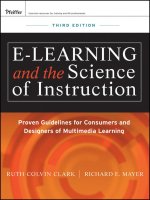e-learning and the science of instruction proven guidelines for consumers and designers of multimedia learning, third edition
Bạn đang xem bản rút gọn của tài liệu. Xem và tải ngay bản đầy đủ của tài liệu tại đây (7.99 MB, 527 trang )
ffirs.indd ivffirs.indd iv 6/21/11 11:19:06 AM6/21/11 11:19:06 AM
About This Book
Why is
e-Learning and the Science of Instruction
important?
This is a book about what works in e-learning. Increasingly, organizations are turning to
e-learning to save travel costs and instructional time. In fact since our fi rst edition of this
book, e-learning in both synchronous and asynchronous formats has risen to account for over
one-third of all delivery of workforce instruction. However, dollars saved are only an illusion
if the quality of the training does not pay off in improved job performance.
Many books on the market offer useful advice for design and development of e-learning.
But unlike these books, the guidelines we present are not based on opinion; but rather on
empirical research. Much of this new research is inaccessible to those producing or evaluating
online learning because it has been distributed primarily within the academic research com-
munity. This book bridges the gap by summarizing research-based answers to questions that
practitioners ask about effective e-learning.
What’s new in the third edition?
The popularity of the fi rst two editions is testimony to consumer interest in evidence-based
guidelines on how to best use visuals, text, audio, practice exercises, and examples in
e- learning. In our third edition we have updated all chapters, adding new research, guidelines,
and examples. You will also fi nd a new chapter on the basics of evidence-based training.
To illustrate our guidelines, we have added new storyboards from an asynchronous lesson on
Excel, a synchronous lesson on Excel, and an asynchronous lesson on pharmaceutical sales.
As a result of the popularity of previous editions as a text, we have also added an instruc-
tor guide, which is available on the publisher’s website. Contact your Pfeiffer representative
to access it.
What can you achieve with this book?
If you are a designer, developer, or consumer of e-learning, you can use the guidelines in this
book to ensure that your courseware meets human psychological learning requirements. In
particular you can learn the best ways to:
Communicate your content with visuals, audio, and text;
Avoid overloading learners with extraneous media effects;
•
•
ffirs.indd iffirs.indd i 6/21/11 11:19:04 AM6/21/11 11:19:04 AM
Leverage social presence to encourage deeper learning;
Design examples and practice exercises that help learners build new skills;
Use networked collaborative facilities effectively for learning;
Defi ne the best navigational schemes for your learners;
Design e-learning to help learners build problem-solving skills; and
Evaluate simulations and games relevant to your instructional goals.
How is this book organized?
Chapters 1 through 3 lay the foundation for the book by defi ning e-learning, describing how
the methods used in e-learning can promote or defeat learning processes, and summarizing
the basics of evidence-based practice.
Chapters 4 through 10 summarize the multimedia principles developed by over twenty-
fi ve years of research by Richard Mayer at the University of California. In these chapters you
will read the guidelines, the evidence, and examples of how to best use visuals, text, and
audio, as well as content segmenting and sequencing in e-learning.
Chapters 11 through 15 focus on guidelines related to important instructional methods
and approaches in e-learning, including use of examples, practice and feedback, collaboration
facilities, navigation tools, and techniques to help learners build problem-solving skills.
Chapter 16 updates the research and presents issues to consider in use of games and simu-
lations in e-learning.
Chapter 17 integrates all of the book’s guidelines into a comprehensive checklist and
illustrates how they apply in concert to asynchronous and synchronous e-learning examples.
See the Introduction for a more detailed summary of what is covered in each chapter.
•
•
•
•
•
•
ffirs.indd iiffirs.indd ii 6/21/11 11:19:05 AM6/21/11 11:19:05 AM
About Pfeiffer
Pfeiffer serves the professional development and hands-on resource needs of training and
human resource practitioners and gives them products to do their jobs better. We deliver
proven ideas and solutions from experts in HR development and HR management, and we
offer effective and customizable tools to improve workplace performance. From novice to
seasoned professional, Pfeiffer is the source you can trust to make yourself and your organi-
zation more successful.
Essential Knowledge Pfeiffer produces insightful, practical, and comprehen-
sive materials on topics that matter the most to training and HR professionals. Our
Essential Knowledge resources translate the expertise of seasoned professionals into practical,
how-to guidance on critical workplace issues and problems. These resources are supported by
case studies, worksheets, and job aids and are frequently supplemented with CD-ROMs,
websites, and other means of making the content easier to read, understand, and use.
Essential Tools Pfeiffer’s Essential Tools resources save time and expense by
offering proven, ready-to-use materials—including exercises, activities, games, instru-
ments, and assessments—for use during a training or team-learning event. These resources are
frequently offered in looseleaf or CD-ROM format to facilitate copying and customization of
the material.
Pfeiffer also recognizes the remarkable power of new technologies in expanding the reach
and effectiveness of training. While e-hype has often created whizbang solutions in search of
a problem, we are dedicated to bringing convenience and enhancements to proven training
solutions. All our e-tools comply with rigorous functionality standards. The most appropriate
technology wrapped around essential content yields the perfect solution for today’s on-the-
go trainers and human resource professionals.
Essential resources for training and HR professionals
ffirs.indd iiiffirs.indd iii 6/21/11 11:19:05 AM6/21/11 11:19:05 AM
ffirs.indd ivffirs.indd iv 6/21/11 11:19:06 AM6/21/11 11:19:06 AM
e-Learning
and the
Science of
Instruction
ffirs.indd vffirs.indd v 6/21/11 11:19:06 AM6/21/11 11:19:06 AM
The Instructor’s Manual for the third edition of e-Learning and the Science of
Instruction is available free online. If you would like to download and print
out a copy of the manual, please visit: www.wiley.com/college/clark
ffirs.indd viffirs.indd vi 6/21/11 11:19:06 AM6/21/11 11:19:06 AM
e-Learning
and the
Science of
Instruction
Proven Guidelines for Consumers and
Designers of Multimedia Learning
Third Edition
Ruth Colvin Clark • Richard E. Mayer
ffirs.indd viiffirs.indd vii 6/21/11 11:19:06 AM6/21/11 11:19:06 AM
Copyright © 2008, 2011 by John Wiley & Sons, Inc. All Rights Reserved.
Published by Pfeiffer
An Imprint of Wiley
989 Market Street, San Francisco, CA 94103-1741 www.pfeiffer.com
No part of this publication may be reproduced, stored in a retrieval system, or transmitted in any form or by any means,
electronic, mechanical, photocopying, recording, scanning, or otherwise, except as permitted under Section 107 or 108 of
the 1976 United States Copyright Act, without either the prior written permission of the Publisher, or authorization through
payment of the appropriate per-copy fee to the Copyright Clearance Center, Inc., 222 Rosewood Drive, Danvers, MA
01923, 978-750-8400, fax 978-646-8600, or on the web at www.copyright.com. Requests to the Publisher for permission
should be addressed to the Permissions Department, John Wiley & Sons, Inc., 111 River Street, Hoboken, NJ 07030,
201-748-6011, fax 201-748-6008, or online at />Limit of Liability/Disclaimer of Warranty: While the publisher and author have used their best efforts in preparing this
book, they make no representations or warranties with respect to the accuracy or completeness of the contents of this
book and specifi cally disclaim any implied warranties of merchantability or fi tness for a particular purpose. No warranty
may be created or extended by sales representatives or written sales materials. The advice and strategies contained herein may
not be suitable for your situation. You should consult with a professional where appropriate. Neither the publisher
nor author shall be liable for any loss of profi t or any other commercial damages, including but not limited to special,
incidental, consequential, or other damages.
Readers should be aware that Internet websites offered as citations and/or sources for further information may have
changed or disappeared between the time this was written and when it is read.
For additional copies/bulk purchases of this book in the U.S. please contact 800-274-4434.
Pfeiffer books and products are available through most bookstores. To contact Pfeiffer directly call our Customer Care
Department within the U.S. at 800-274-4434, outside the U.S. at 317-572-3985, fax 317-572-4002, or visit www.
pfeiffer.com.
Pfeiffer also publishes its books in a variety of electronic formats. Some content that appears in print may not be
available in electronic books.
ISBN 978-0-470-87430-1 (cloth); 978-1-118-08616-2 (ebk); 978-1-118-08617-9 (ebk); 978-1-118-08621-6 (ebk)
Library of Congress Cataloging-in-Publication Data
Clark, Ruth Colvin.
E-learning and the science of instruction : proven guidelines for consumers and designers of multimedia learning /
Ruth C. Clark, Richard E. Mayer. — 3rd ed.
p. cm.
Includes bibliographical references and index.
ISBN 978-0-470-87430-1 (hardback)
1. Business education—Computer-assisted instruction. I. Mayer, Richard E., 1947- II. Title. III. Title:
ELearning and the science of instruction.
HF1106.C55 2011
658.3'12402854678–dc22
2011012858
Acquiring Editor: Matthew Davis Production Editor: Michael Kay
Marketing Manager: Brian Grimm Editor: Rebecca Taff
Director of Development: Kathleen Dolan-Davies Editorial Assistant: Michael Zelenko
Developmental Editor: Susan Rachmeler Manufacturing Supervisor: Becky Morgan
Printed in the United States of America
third edition
Printing 10 9 8 7 6 5 4 3 2 1
ffirs.indd viiiffirs.indd viii 6/21/11 11:19:06 AM6/21/11 11:19:06 AM
ix
Acknowledgments xvii
Introduction 1
1. e-Learning: Promise and Pitfalls 7
What Is e-Learning? 8
Is e-Learning Better? 11
The Promise of e-Learning 14
The Pitfalls of e-Learning 19
Inform and Perform e-Learning Goals 20
e-Learning Architectures 22
What Is Effective e-Courseware? 23
Learning in e-Learning 25
CONTENTS
toc.indd ixtoc.indd ix 6/21/11 11:20:34 AM6/21/11 11:20:34 AM
x
Contents
2. How Do People Learn from e-Courses? 29
How Do People Learn? 31
How e-Lessons Affect Human Learning 39
What We Don’t Know About Learning 44
3. Evidence-Based Practice 49
What Is Evidence-Based Practice? 50
Three Approaches to Research on Instructional Effectiveness 51
What to Look for in Experimental Comparisons 55
How to Interpret No Effect in Experimental Comparisons 57
How to Interpret Research Statistics 58
How Can You Identify Relevant Research? 61
What We Don’t Know About Evidence-Based Practice 62
4. Applying the Multimedia Principle: Use Words and Graphics
Rather Than Words Alone 67
Do Visuals Make a Difference? 69
Multimedia Principle: Include Both Words and Graphics 70
Some Ways to Use Graphics to Promote Learning 74
Psychological Reasons for the Multimedia Principle 78
Evidence for Using Words and Pictures 79
The Multimedia Principle Works Best for Novices 83
Should You Change Static Illustrations into Animations? 84
What We Don’t Know About Visuals 86
5. Applying the Contiguity Principle: Align Words
to Corresponding Graphics 91
Contiguity Principle 1: Place Printed Words Near Corresponding
Graphics 93
Contiguity Principle 2: Synchronize Spoken Words with
Corresponding Graphics 102
Psychological Reasons for the Contiguity Principle 104
toc.indd xtoc.indd x 6/21/11 11:20:34 AM6/21/11 11:20:34 AM
Contents xi
Evidence for Presenting Printed Words Near Corresponding
Graphics 106
Evidence for Presenting Spoken Words at the Same Time
as Corresponding Graphics 109
What We Don’t Know About Contiguity 110
6. Applying the Modality Principle: Present Words as Audio
Narration Rather Than On-Screen Text 115
Modality Principle: Present Words as Speech Rather
Than On-Screen Text 117
Limitations to the Modality Principle 119
Psychological Reasons for the Modality Principle 121
Evidence for Using Spoken Rather Than Printed Text 123
When the Modality Principle Applies 128
What We Don’t Know About Modality 129
7. Applying the Redundancy Principle: Explain Visuals with Words
in Audio OR Text: Not Both 133
Redundancy Principle 1: Do Not Add On-Screen Text to Narrated
Graphics 135
Psychological Reasons for the Redundancy Principle 137
Evidence for Omitting Redundant On-Screen Text 139
Redundancy Principle 2: Consider Adding On-Screen Text
to Narration in Special Situations 141
Psychological Reasons for Exceptions to the Redundancy Principle 142
Evidence for Including Redundant On-Screen Text 144
What We Don’t Know About Redundancy 146
8. Applying the Coherence Principle: Adding Material
Can Hurt Learning 151
Coherence Principle 1: Avoid e-Lessons with Extraneous Audio 153
Psychological Reasons to Avoid Extraneous Audio in e-Learning 156
Evidence for Omitting Extraneous Audio 157
toc.indd xitoc.indd xi 6/21/11 11:20:34 AM6/21/11 11:20:34 AM
Contents
xii
Coherence Principle 2: Avoid e-Lessons with Extraneous
Graphics 159
Psychological Reasons to Avoid Extraneous Graphics in
e-Learning 160
Evidence for Omitting Extraneous Graphics Added for Interest 161
Evidence for Using Simpler Visuals 164
Coherence Principle 3: Avoid e-Lessons with Extraneous
Words 166
Psychological Reasons to Avoid Extraneous Words in
e-Learning 168
Evidence for Omitting Extraneous Words Added for Interest 168
Evidence for Omitting Extraneous Words Added to Expand
on Key Ideas 170
Evidence for Omitting Extraneous Words Added for
Technical Depth 172
What We Don’t Know About Coherence 172
9. Applying the Personalization Principle: Use Conversational
Style and Virtual Coaches 179
Personalization Principle 1: Use Conversational Rather
Than Formal Style 182
Psychological Reasons for the Personalization Principle 183
Evidence for Using Conversational Style 185
Promote Personalization Through Voice Quality 188
Promote Personalization Through Polite Speech 189
Personalization Principle 2: Use Effective On-Screen Coaches
to Promote Learning 191
Personalization Principle 3: Make the Author Visible to Promote
Learning 197
Psychological Reasons for Using a Visible Author 200
Evidence for the Visible Author 200
What We Don’t Know About Personalization 201
toc.indd xiitoc.indd xii 6/21/11 11:20:35 AM6/21/11 11:20:35 AM
Contents xiii
10. Applying the Segmenting and Pretraining Principles: Managing
Complexity by Breaking a Lesson into Parts 205
Segmenting Principle: Break a Continuous Lesson into Bite-Size
Segments 207
Psychological Reasons for the Segmenting Principle 210
Evidence for Breaking a Continuous Lesson into Bite-Size
Segments 211
Pretraining Principle: Ensure That Learners Know the Names
and Characteristics of Key Concepts 212
Psychological Reasons for the Pretraining Principle 214
Evidence for Providing Pretraining in Key Concepts 216
What We Don’t Know About Segmenting and Pretraining 218
11. Leveraging Examples in e-Learning 223
What Are Worked Examples? 224
The Psychology of Worked Examples 227
Evidence for the Benefi ts of Worked Examples 227
Worked Example Principle 1: Fade from Worked Examples
to Problems 229
Worked Example Principle 2: Promote Self-Explanations 231
Worked Example Principle 3: Include Instructional Explanations
of Worked Examples in Some Situations 234
Worked Example Principle 4: Apply Multimedia Principles
to Examples 235
Worked Example Principle 5: Support Learning Transfer 239
Design Guidelines for Far Transfer Worked Examples 240
What We Don’t Know About Worked Examples 245
12. Does Practice Make Perfect? 251
What Is Practice in e-Learning? 253
The Paradox of Practice 255
toc.indd xiiitoc.indd xiii 6/21/11 11:20:35 AM6/21/11 11:20:35 AM
Contents
xiv
Practice Principle 1: Add Suffi cient Practice Interactions to e-Learning
to Achieve the Objective 257
Practice Principle 2: Mirror the Job 262
Practice Principle 3: Provide Effective Feedback 263
Practice Principle 4: Distribute and Mix Practice Among Learning
Events 267
Practice Principle 5: Apply Multimedia Principles 272
Practice Principle 6: Transition from Examples to Practice
Gradually 274
What We Don’t Know About Practice 274
13. Learning Together Virtually 279
What Is Collaborative Learning? 280
What Is Computer-Supported Collaborative
Learning (CSCL)? 284
Some Generalizations About Collaboration 288
CSCL Research Summaries 292
Structured Controversy 300
CSCL: The Bottom Line 303
What We Don’t Know About CSCL 303
14. Who’s in Control? Guidelines for e-Learning Navigation 309
Learner Control Versus Program Control 311
Do Learners Make Good Instructional Decisions? 315
Learner Control Principle 1: Give Experienced Learners Control 319
Learner Control Principle 2: Make Important Instructional Events
the Default 322
Learner Control Principle 3: Consider Adaptive Control 323
Learner Control Principle 4: Give Pacing Control 327
Learner Control Principle 5: Offer Navigational Support
in Hypermedia Environments 329
What We Don’t Know About Learner Control 333
toc.indd xivtoc.indd xiv 6/21/11 11:20:35 AM6/21/11 11:20:35 AM
Contents xv
15. e-Learning to Build Thinking Skills 339
Three Types of Thinking Skills 341
Can Thinking Skills Be Trained? 343
Thinking Skills Principle 1: Focus on Job-Specifi c Cognitive
and Metacognitive Skills 344
Thinking Skills Principle 2: Consider a Whole-Task
Course Design 345
Evidence for Whole-Task Instruction 351
Thinking Skills Principle 3: Make Thinking Processes Explicit 355
Thinking Skills Principle 4: Defi ne Job-Specifi c Thinking
Processes 360
Teaching Thinking Skills: The Bottom Line 363
What We Don’t Know About Teaching Thinking Skills 364
16. Simulations and Games in e-Learning 369
The Case for Simulations and Games 372
What Are Simulations and Games? 374
Do Games and Simulations Teach? 378
Games and Simulations Principle 1: Match Game Types
to Learning Goals 381
Games and Simulations Principle 2: Make Learning Essential
to Game Progress 382
Games and Simulations Principle 3: Build in Proven Instructional
Strategies 382
Games and Simulations Principle 4: Build in Guidance
and Structure 386
Games and Simulations Principle 5: Manage Complexity 389
Games and Simulations Principle 6: Make Relevance Salient 393
What We Don’t Know About Games and Simulations 394
17. Applying the Guidelines 401
Applying Evidence-Based Guidelines to e-Courses 401
toc.indd xvtoc.indd xv 6/21/11 11:20:35 AM6/21/11 11:20:35 AM
Contents
xvi
e-Lesson Reviews 404
Review of Sample 1: Asynchronous e-Lesson on Excel
for Small Business 409
Review of Sample 2: Synchronous e-Lesson on Excel 414
Review of Sample 3: Automotive Troubleshooting Simulation 418
Refl ections on Past Predictions 421
Beyond 2011 423
In Conclusion 424
References 425
Glossary 453
List of Tables and Figures 475
Name Index 487
Subject Index 493
About the Authors 501
Pfeiffer Publications Guide 503
toc.indd xvitoc.indd xvi 6/21/11 11:20:35 AM6/21/11 11:20:35 AM
xvii
ACKNOWLEDGMENTS
I
N THIS THIRD EDITION, we have added new sample lessons to
illustrate the application and violation of our principles. We are grateful
for the talents of Mark Palmer, who created the asynchronous Excel and sales
storyboards.
We acknowledge the many instructional researchers throughout the
world whose work has contributed to this book. In particular, we thank
the following researchers and practitioners who gave us access to their
examples and research for inclusion in this third edition:
Robert Atkinson, Arizona State University
Dale Bambrick, Raytheon Professional Services
Lance Dublin, Dublin Consulting
flast.indd xviiflast.indd xvii 6/18/11 1:51:24 PM6/18/11 1:51:24 PM
Acknowledgments
xviii
Susanne Lajoie, McGill University
Lloyd Rieber, University of Georgia
Dan Suthers, University of Hawaii
Finally, we are grateful to support we received from the Pfeiffer team,
especially to Matt Davis for editorial support.
flast.indd xviiiflast.indd xviii 6/18/11 1:51:24 PM6/18/11 1:51:24 PM
1
INTRODUCTION
GETTING THE MOST FROM THIS RESOURCE
Purpose
The training fi eld is undergoing an evolution from a craft based on fads
and folk wisdom to a profession that integrates evidence into the design and
development of its products. Part of the training revolution has been driven
by the use of digital technology to manage and deliver instructional solutions.
This book provides you with evidence-based guidelines for both self-study
(asynchronous) and virtual classroom (synchronous) forms of e-learning.
Here you will learn the guidelines, the evidence, and examples to shape your
decisions about the design, development, and evaluation of e-learning.
Audience
If you are a designer, developer, or consumer of e-learning, you can use
the guidelines in this book to ensure that your courseware meets human
cintro.indd 1cintro.indd 1 6/18/11 1:50:28 PM6/18/11 1:50:28 PM
e-Learning and the Science of Instruction
2
psychological learning requirements. Although most of our examples focus
on workforce learning, we believe instructional professionals in the educa-
tional and academic arenas can equally benefi t from our guidelines.
Package Components
For this third edition we have added an instructor guide that includes many
resources. The instructor guide is located on the Pfeiffer website. Contact
your Pfeiffer representative for access.
Table I.1 summarizes the content of the book’s chapters. We have added
a new Chapter 3, which describes the basics of evidence-based practice.
We have updated the research in all of the chapters and added new story-
board examples for a lesson on Excel as well as for a more strategic skill of
consultative selling.
Table I.1. A Preview of Chapters.
Chapter Topics
1. e-Learning Promise and
Pitfalls
Our defi nition of e-learning
Evidence on e-learning effectiveness
The promise and pitfalls of e-Learning
Inform versus perform outcome goals
Three architectures for e-learning design
•
•
•
•
•
2. How People Learn from
e-Courses
An overview of human learning processes
and how instructional methods can support or
disrupt them
•
3. Evidence-Based Practice What is evidence-based practice?
Three approaches to research on instructional
effectiveness
The features of effective experimental
comparisons
An introduction to the statistical concepts
in the book
•
•
•
•
cintro.indd 2cintro.indd 2 6/18/11 1:50:28 PM6/18/11 1:50:28 PM
Introduction 3
Table I.1. (Continued).
Chapter Topics
4. Applying the Multimedia
Principle: Use Words and
Graphics Rather Than
Words Alone
Evidence for whether learning is improved in
e-lessons that include visuals
Types of visuals that best promote learning
Who benefi ts most from visuals?
Static illustrations Versus animations
•
•
•
•
5. Applying the Contiguity
Principle: Align Words to
Corresponding Graphics
Evidence for the best placement of text and
graphics on the screen
Evidence for sequencing of text or audio in
conjunction with visuals
Situations in which the contiguity principle is most
applicable as well as the psychological basis for this
principle
•
•
•
6. Applying the Modality
Principle: Present Words
as Audio Narration Rather
than On-Screen Text
Evidence for presenting words that describe
graphics in audio rather than in text
When the modality principle is and is not applicable
as well as the psychological basis for the principle
•
•
7. Applying the Redundancy
Principle: Explain Visuals
with Words in Audio OR
Text: Not Both
Evidence for use of audio to explain graphics rather
than text and audio
Situations when adding on-screen text to narration
can be helpful to learning
•
•
8. Applying the Coherence
Principle: Adding Extra
Material Can Hurt Learning
Evidence for omitting distracting graphics and stories,
irrelevant audio, and detailed textual explanations
Evidence for using simple rather than complex visuals
Evidence for omitting extraneous words added for
interest, to expand on key ideas or for technical depth
•
•
•
9. Applying the
Personalization Principle:
Use Conversational Style
and Virtual Coaches
Evidence for conversational style, voice quality, and
polite speech to improve learning
Situations in which the personalization principle is
most applicable
Evidence for best design of computer agents to
promote learning
Evidence for making the author visible to the
learner through the script
(Continued )
•
•
•
•
cintro.indd 3cintro.indd 3 6/18/11 1:50:28 PM6/18/11 1:50:28 PM
e-Learning and the Science of Instruction
4
Table I.1. (Continued).
Chapter Topics
10. Applying the Segmenting
and Pre-Training
Principles: Managing
Complexity by Breaking a
Lesson into Parts
Evidence for breaking a continuous lesson into bite-
size segments and allowing learners to access each
segment at their own rate
Evidence for sequencing key concepts in a lesson
prior to the main procedure or process of that
lesson
•
•
11. Leveraging Examples in
e-Learning
Worked examples for well-structured tasks, strategic
tasks, and modeling examples
Evidence and guidelines to transition from examples
to practice assignments through fading
Ways to ensure examples are processed by adding
questions that promote self-explanations or by
methods that promote active observation
How to design examples that support learning of
strategic skills
•
•
•
•
12. Does Practice Make
Perfect?
Evidence for the amount and type of practice
needed to support learning objectives
Evidence and guidelines for design of effective
practice feedback
Evidence for the distribution and grouping of
practice within and among your lessons
•
•
•
13. Learning Together
Virtually
Factors proven to promote learning from
collaborative assignments
Summary of types of computer-supported
collaborative learning
Samples of research studies on computer-supported
collaborative learning
Use of structured controversy as one proven
collaborative learning method
•
•
•
•
cintro.indd 4cintro.indd 4 6/18/11 1:50:28 PM6/18/11 1:50:28 PM
Introduction 5
Table I.1. (Continued).
Chapter Topics
14. Who’s in Control?
Guidelines for e-Learning
Navigation
Distinction between learner and program control
When to use learner versus program control
Techniques for dynamically adapting instruction to
evolving learner needs
Techniques for navigational aids in hypermedia
environments
•
•
•
•
15. e-Learning to Build
Thinking Skills
Three types of thinking skills
Evidence on the effectiveness of thinking skills
training programs
Features of and evidence for whole-task instruction
Guidelines for making thinking processes explicit in
e-learning
An introduction to cognitive task analysis to defi ne
expert thinking skills
•
•
•
•
•
16. Simulations and Games
in e-Learning
What are simulations and games?
Evidence for effectiveness of simulations and games
Techniques to ensure the learning effectiveness of
simulations and games
•
•
•
17. Applying the Guidelines A checklist and summary of the guidelines
in the book
Three discussions of how the guidelines apply to e-
learning samples
•
•
Glossary
The Glossary provides defi nitions of the technical terms used throughout
the book.
cintro.indd 5cintro.indd 5 6/18/11 1:50:29 PM6/18/11 1:50:29 PM









